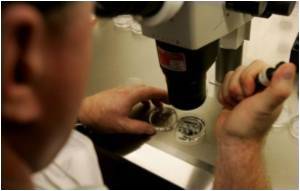Scientists at Dana-Farber Cancer Institute and Brigham and Women's Hospital have caused cells in a rare, lethal form of cancer to begin behaving like normal cells

"NUT midline carcinoma arises people of all ages, but predominantly in children and young adults," explained the study's senior co-author, James Bradner, MD, of Dana-Farber. "It usually originates in the chest, sometimes in the head or neck, and is often mistaken for other types of cancer. Traditional therapy involves surgery, radiation, and chemotherapy, but even in combination these approaches don't work well: most patients live only about nine and a half months after diagnosis. As we've learned more about the molecular basis of the disease, we've begun to be able to devise therapies against it."
The cause of the disease was discovered by Christopher French, MD, a senior author of the study from Brigham and Women's Hospital. It results from a "translocation" in which two genes from different chromosomes stick together and give rise to an abnormal, fused protein called BRD4-NUT. While Bradner and his colleagues have subsequently developed and studied compounds that target BRD4-NUT directly, the newly published study involves a more oblique approach.
Researchers discovered that BRD4-NUT causes cells to become cancerous by attaching to DNA's packing material within the nucleus -- a band of proteins known as histones, part of the machinery for switching genes on and off. BRD4-NUT essentially locks down the machinery's control panel, preventing changes that allow cells to develop into mature, stable, slow-growing adults, leaving them in a state of perpetual, hyperactive youth.
To interfere with BRD4-NUT's affinity for histones, French and Bradner tried a diversionary tactic. They treated NMC cells with a substance called an HDAC (histone deacetylase) inhibitor, which creates competing binding sites for BRD4-NUT throughout the nucleus. The hope was that, like a burglar who bypasses one house for the promise of a bigger prize in another, the HDAC inhibitor would lure BRD4-NUT away from certain locations in the genome.
In laboratory experiments, they found that NMC cells treated with an HDAC inhibitor turned into ordinary, non-dividing skin cells -- a process known as "differentiation," which has been a central goal of cancer research for well over half a century. In studies with animals engrafted with NMC tissue, animals treated with HDAC inhibitors had slower-growing tumors and lived longer than those who were not treated.
Advertisement
The inspiration for this approach came from earlier research by French. About five years ago, he was investigating the effect of HDAC inhibitors on cell memory -- the ability of cells to "remember" the type of cell they are as they divide. "HDAC inhibitors can alter cell memory," French explained. "We hypothesized that treating NMC cells with these inhibitors would change the cells' memory and modify their identity. What happened was that the cells remembered what type of cell they initially were and switched back to being normal skin-like cells. BRD4-NUT, it turns out, interferes with cell memory. Blocking the protein with HDAC inhibitors restores that memory."
Advertisement
"The inhibitor used in the patient described in this study was a first-generation agent, and we're optimistic that future versions will be both more effective and easier for patients to tolerate," Bradner said. "To our knowledge, this study represents the first time a targeted drug has demonstrated anti-cancer activity against this devastating tumor. The same approach may prove beneficial against other cancers as well."
Source-Eurekalert














